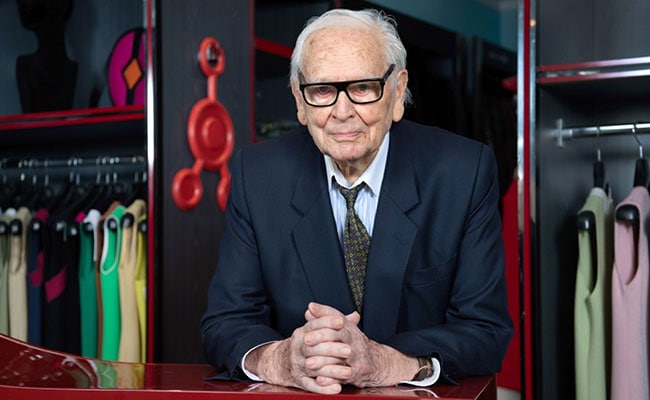Years earlier than the Apollo eleven venture, and proper earlier than the release of Stanley Kubrick’s “2001: A Space Odyssey,” style designer Pierre Cardin, who founded his eponymous label in Paris in 1950, become actively imagining life on the galactic frontier. His outré mod models gave contours to the visual and stylistic zeitgeist of the Space Age.

“My favorite garment is the only I invent for an existence that does not but exists,” he is regularly quoted pronouncing, “the arena of the day after today.” Cardin reinvented the miniskirt with razor-sharp, geometric silhouettes, jewelry-sized adornments, massive zippers, and cutouts. He made knitwear unitards, codpieces, and jumpsuits for any gender. Innovative synthetic materials like acrylic, vinyl, sequins, Lurex, and shimmering metals are regularly featured in his designs. He labored with af cloth called Dynel, a fabric that would be heat-molded into complex patterned folds, advertising a version of it below the name Cardine.
He dreamed up domed glass helmets and architectural hats in punchy, block coloration, a fashion designer of ensembles. He produced otherworldly outfits and captured the public creativeness for a day when space tour is probably not unusual. Born in Italy as the youngest of 10 siblings, Cardin moved to France as a younger infant while his own family fled to Saint-Étienne to escape fascism. He worked several component-time jobs as a pupil, consisting of paintings with a tailor, earlier than leaving for Paris in 1945 to become a couturier.
Once there, he labored for the House of Paquin and Elsa Schiaparelli and later labored beneath Christian Dior throughout the “New Look” technology, earlier than hanging out to set up his couture house in 1950. His stylish designs discovered customers amongst wealthy socialites and the likes of US First Lady Jacqueline Kennedy. On the screen and in magazines, in the meantime, Jeanne Moreau, Brigitte Bardot, and Mia Farrow telegraphed his skills to a mainstream pop audience.
It changed into Cardin’s early tutelage in conventional tailoring that allowed him to deftly deconstruct conventions in the futuristic designs that became his trademark. By the past due Nineteen Fifties, he had created his first menswear collection, later designing an iconic collection of collarless fits for The Beatles.
The 1964 release of Cardin’s Cosmocorps collection, entire with brightly colored jumpsuits and unitards, encouraged the unisex uniforms of the “Star Trek” crew. His distinctive aesthetic was even aped the animated tv display “The Jetsons,” when the family matriarch, Judy, sports a terrific “Pierre Martian authentic” complete with soaring collar and illuminating bodice, a function that would indeed make its manner into Cardin’s designs via 1968, together with his battery-powered “gown electronique.”
“Pierre had commenced following the whole area race from the Nineteen Fifties onward, and it truly coincided with the development of his career,” stated Matthew Yokobosky, curator of “Future Fashion,” a brand new career retrospective focused on Cardin’s couture portions. “He’d been running on those silhouettes, growing those fantasies. Cardin is often mentioned inside the same breath as André Courrèges, Emanuel Ungaro (and) Paco Rabanne, but had those large breakout moments where his work surely described a sense that stood other than the entirety else.”
Featuring over 170 works, the display opens this weekend at the Brooklyn Museum. It has been timed to coincide with the 50th anniversary of the Apollo eleven moon landing — an occasion that immediately formed Cardin’s paintings. “He went to NASA’s Houston headquarters in 1969, proper once they had landed and again from the moon, so it wasn’t this fable anymore,” stated Yokobosky. “He tried on Neil Armstrong’s spacesuit, (he become) one of the few civilians to ever accomplish that.”
Even at the age of 97, Cardin’s gaze remains constant on the future: “In 2069, we can all walk at the moon or Mars carrying ‘Cosmocorps’ ensembles,” he predicts. “Women will wear Plexiglas cloche hats and tube clothing; men will put on elliptical pants and kinetic tunics.””
At the time, Cardin’s mid-century visions presented a decidedly constructive future defined via the opportunity of development, experimentation, and exploration. Viewed nowadays, his work gives a wonderfully extraordinary portrait of the unknown and a welcome analgesic to the modern-day weather of fear.
“What humans notion the future seemed like within the ’60s isn’t what we assume the destiny goes to appear to be nowadays, because it’s a distinctive society, but he made a breakthrough,” said Yokobosky. “We might not all be carrying (his visions) nowadays. However, Cardin changed into radical and formidable enough to make humans take dangers and marvel: What else should there be in the destiny?”

